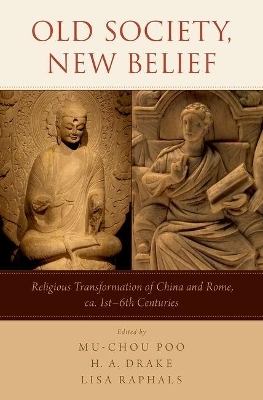
Old Society, New Belief
Oxford University Press Inc (Verlag)
978-0-19-027835-9 (ISBN)
In the first century of the Common Era, two new belief systems entered long-established cultures with radically different outlooks and values: missionaries started to spread the teachings of Jesus of Nazareth in Rome and the Buddha in China. Rome and China were not only ancient cultures, but also cultures whose elites felt no need to receive the new beliefs. Yet a few centuries later the two new faiths had become so well-established that their names were virtually synonymous with the polities they had entered as strangers. Although there have been numerous studies addressing this phenomenon in each field, the difficulty of mastering the languages and literature of these two great cultures has prevented any sustained effort to compare the two influential religious traditions at their initial period of development.
This book brings together specialists in the history and religion of Rome and China with a twofold aim. First, it aims to show in some detail the similarities and differences each religion encountered in the process of merging into a new cultural environment. Second, by juxtaposing the familiar with the foreign, it also aims to capture aspects of this process that could otherwise be overlooked. This approach is based on the general proposition that, when a new religious belief begins to make contact with a society that has already had long honored beliefs, certain areas of contention will inevitably ensue and changes on both sides have to take place. There will be a dynamic interchange between the old and the new, not only on the narrowly defined level of "belief," but also on the entire cultural body that nurtures these beliefs. Thus, this book aims to reassess the nature of each of these religions, not as unique cultural phenomena but as part of the whole cultural dynamics of human societies.
Mu-chou Poo was a Research Fellow at the Institute of History and Philology, Academia Sinica, Taipei from 1984-2009, and has been Professor of History at the Chinese University of Hong Kong since 2009. H. A. Drake received his PhD in ancient history from the University of Wisconsin, Madison, in 1970. He has spent his entire career at the University of California, Santa Barbara, where he specializes in the history of the later Roman empire and interaction between Christians and pagans in the fourth century. Lisa Raphals has been a Professor at the University of California, Riverside since 1998.
Table of Contents
Preface
Contributors
List of Figures and Credits
Introduction: Old Society, New Faith (Mu-chou Poo and H.A. Drake)
Part One. Initial Encounters and Causes of Resistance
Chapter 1 "Buddhism enters China" in Early Medieval China (Robert Campany)
Chapter 2 Christianity and Rome: A Study in Power Relationships (H.A. Drake)
Chapter 3 Aesthetics of Enlightenment: Philosophical Continuity and Rhetorical Innovation in the Poetics of Roman Architecture (Mira Seo)
Chapter 4 Justin Martyr and Tatian: Christian reactions to encounters with Greco-Roman culture and imperial persecution (Hyun Jin Kim)
Chapter 5 When Buddhism Meets the Chen-Wei Prophetic and Apocryphal Discourse: A Religious Encounter in Early Medieval China (Zongli Lu)
Chapter 6 Honoring the Dead: The Buddhist Reinvention of Portrait Eulogies in Early Medieval China (Huai-yu Chen)
Part Two. Interaction, Influence, and Accommodation
Chapter 7 Buddhism Challenged, Adopted, and in Disguise: Daoist and Buddhist Interactions in Medieval China (Gil Raz)
Chapter 8 Roman Allotment and the Election of Bishops (Roberta Stewart)
Chapter 9 Colonizing the Supernatural: How Daim?n Became Demonized in Late Antiquity (Sze-kar Wan)
Chapter 10 The Taming of Ghosts in Early Buddhism (Mu-chou Poo)
Chapter 11 A Matter of Life and Death: the Development of Nirvana Images in the Northern Dynasties (Chuan-Ying Yen)
Part Three. Synthesis and Assimilation
Chapter 12 Pagan Statues, Christian City: Constantinople and the Parastaseis Syntomoi Chronikai (Paroma Chatterjee)
Chapter 13 Adaptation and Assimilation of Buddhism in China as reflected in Monastic Architecture (Yin Zhou)
Chapter 14 Understanding Retribution in a Changing Religious Landscape: The Case of Yan Zhitui ??? (531-591) (Natasha Heller)
Chapter 15 From Superstitio to Heresy: Law and Divine Justice (Fourth-Fifth Centuries CE) (Michele Renee Salzman)
Conclusion: Comparative Perspectives on China and Rome (Lisa Raphals)
| Erscheinungsdatum | 14.05.2017 |
|---|---|
| Zusatzinfo | 22; 14 b&w halftone, 8 b&w line art |
| Verlagsort | New York |
| Sprache | englisch |
| Maße | 236 x 163 mm |
| Gewicht | 621 g |
| Themenwelt | Geschichte ► Allgemeine Geschichte ► Vor- und Frühgeschichte |
| Geschichte ► Allgemeine Geschichte ► Altertum / Antike | |
| Geisteswissenschaften ► Religion / Theologie ► Weitere Religionen | |
| ISBN-10 | 0-19-027835-8 / 0190278358 |
| ISBN-13 | 978-0-19-027835-9 / 9780190278359 |
| Zustand | Neuware |
| Haben Sie eine Frage zum Produkt? |
aus dem Bereich


